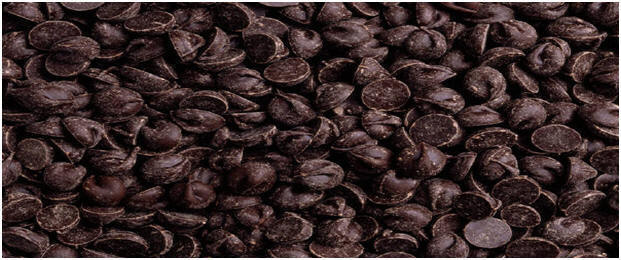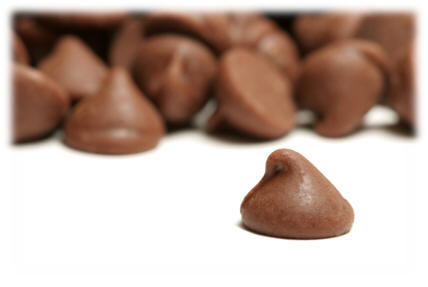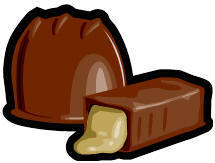L a G r a n E n c i c l o p e d i a I l u s t r a d a d e l P r o y e c t o S a l ó n H o g a r
![]()
Chapter 2: Chocolate's Origin
Read the passage. Then answer questions about the passage below.

Proyecto Salón Hogar
|
Chocolate –– there’s nothing quite like it, is there? Chocolate is simply delicious. What is chocolate? Where does it come from?
Christopher Columbus was probably the first to take cacao beans from the New World to Europe in around 1502. But the history of chocolate goes back at least 4,000 years!
The Aztecs, who lived in America, thought that their bitter cacao drink was a divine gift from heaven. In fact, the scientist Carolus Linnaeus named the plant Theobroma, which means “food of the gods.”
The Spanish explorer Hernando Cortez went to America in 1519. He visited the Mexican emperor Montezuma.
He saw that Montezuma drank cacao mixed with vanilla and spices. Cortez took some cacao home as a gift to the Spanish King Charles. In Spain, people began to drink Cortez’s chocolate in a drink with chili peppers.
However, the natural taste of cacao was too bitter for most people. To sweeten the drink, Europeans added sugar to the cacao drink. As a sweet drink, it became more popular.
By the 17th century, rich people in Europe were drinking it. Later, people started using chocolate in pastries, like pies and cakes. In 1828, Dutch chocolate makers started using a new process for removing the fat from cacao beans, and
getting to the center of the cacao bean.
The Dutch chocolate maker Conrad J. van Houten made a machine that pressed the fat from the bean.
The resulting powder mixed better with water than cacao did. Now, some call van Houten’s chocolate “Dutch chocolate.”
It was easy to mix Dutch chocolate powder with sugar. So other chocolate makers started trying new recipes that used powdered chocolate.
|
Page 1
![]()
|
People started mixing sweetened chocolate with cocoa butter to make solid chocolate bars. In 1849, an English chocolate maker made the first chocolate bar. In the 19th century, the Swiss started making milk chocolate by mixing powdered milk with sweetened chocolate. Milk chocolate has not changed much since this process was invented. Today, two countries - Brazil and Ivory Coast - account for almost half the world’s chocolate. The United States imports most of the chocolate in the world, but the Swiss eat the most chocolate per person. The most chocolate eaten today is sweet milk chocolate, but people also eat white chocolate and dark chocolate. Cocoa and dark chocolate are believed to help prevent heart attacks, or help keep them from happening. They are supposed to be good for the circulatory system. On the other hand, the high fat content of chocolate can cause weight gain, which is not good for people’s health.
Other health claims for chocolate have not been proven, but some research shows that chocolate could be good for the brain. Chocolate is a popular holiday gift. A popular Valentine’s Day gift is a box of chocolate candies with a card and flowers. Chocolate is sometimes given for Christmas and birthdays. Chocolate eggs are sometimes given at Easter. Chocolate is toxic to some animals. An ingredient in chocolate is poisonous to dogs, cats, parrots, small rodents, and some livestock. Their bodies cannot process some of the chemicals found in chocolate. Therefore, they should never be fed chocolate.
|
Page 2
![]()
|
Questions
1) How did people first consume chocolate? A. As a sweet drink B. As a bitter drink C. As a chocolate bar D. In cakes and pastries E. As a white chocolate bar
2) Why did Linaeus name the plant Theobroma? A. Because he believed it to be a “gift from heaven.” B. Because he believed it to be “food of the gods.” C. Because he thought chocolate to be toxic. D. Because chocolate was so rare. E. Both B and C are correct.
3) Who was Montezuma? A. He was an explorer from Mexico. B. He was the emperor of Mexico. C. He was an explorer from Spain. D. He was the king of Spain. E. He was a baker in Spain.
4) Who made the first powdered chocolate? A. Cortez B. Linaeus C. Columbus D. van Houten E. King Charles
5) Which people eat the most chocolate per person? A. The Dutch B. The Swiss C. The English D. The Mexicans E. The Brazilians
|
Page 3
![]()
|
Vocabulary
1) A divine gift is… A. a chocolate gift. B. a gift from God. C. a delicious gift. D. a bitter gift. E. a dangerous gift.
2) Pastries are… A. sweet baked goods. B. bitter–tasting drinks. C. chocolate candy bars . D. chocolate candies. E. Both C and D are correct.
3) What are recipes? A. Herbs and Spices B. Countries C. Machines D. Food ingredients E. Chocolate powders
A. do not let it happen. B. do not discuss it. C. do not allow it. D. do not stop it E. Both A and C are correct. F. Both A and B are correct.
5) If something is toxic it is… A. poisonous. B. disgusting. C. emotional. D. popular. E. harmless.
|
|||||
|
Page 4
Page 5
|
|||||
|
Historical Context In its origins, literature was simply the art or occupation of a literary writer. Now the meaning of literature includes knowledge of everything that has previously been written, or passed on orally. Literature is a reflection of culture. When the work of a writer or storyteller is recognized, admired, and studied for its artistic value and style, it is called literature.
“British Literature," "American Literature," "Literature of the 15th century," and "Puerto Rican Literature," among others - these are the collected works of the entire country, nation, period, or branch of knowledge. You can learn about the development and history of a country through its collection of literary texts. This information tells you about the historical context.
The historical context helps you to understand better the text that you are reading and the importance of that text in history, as well as the influence of history on that text.
A. Explain the historical context of the story " Chocolate’s origin" __________________________________________________________________________________________ __________________________________________________________________________________________ __________________________________________________________________________________________
Vocabulary: The Dictionary and Guide Words To write my essay I'll need a number of reference books, such as a dictionary and a thesaurus to check my spelling and to help me find the best words. Also, an encyclopedia and an atlas will help me to verify facts and find information.
What is a dictionary and how is information found in a dictionary?
A dictionary is a reference book that contains words in alphabetical order. Dictionaries usually contain the following information for each entry: definition or definitions, parts of speech, etymology (the origin and development of the word), syllabification, and information about usage. A dictionary also provides a pronunciation key and examples of grammar, nonstandard, slang, and informal language usage.
Guide words appear in a dictionary at the top of each page. Guide words show the first and last entry on each page of the dictionary.
A. Look up the following words in a dictionary and write the guide words found at the top of each page. 1. fleet: ___________________________________________ 2. conquest: _______________________________________ 3. commercial: _____________________________________ 4. gain: ___________________________________________ 5. adventure: _______________________________________
B. Find the following words in a dictionary. Write down their parts of speech and information about usage. 1. fountain: ____________________________________________________ ____________________________________________________________ 2. miraculous: __________________________________________________ ____________________________________________________________
|
|||||
|
Page 6
|
|||||
|
|
Reference Books What kinds of reference books will you use for your essay?
Reference books are books that people consult to find information on specific matters. An encyclopedia, a thesaurus, and an atlas are three different types of reference books.
Encyclopedias have entries on different subjects arranged alphabetically. The spine of each volume of the encyclopedia shows the alphabetical range of the articles inside. The information is organized by last names, the most important word of a concept, or the first word in a geographical name. A thesaurus lists synonyms and antonyms of words. Words are either listed in alphabetical order or are classified by meaning. In the latter case, one would first find the word in the index to get the page number of the entry. An atlas has maps, geographical names, and information.
A. Write the word you would look up in the encyclopedia to find information about the following people or things. 1. George Washington ______________ 4. The Taíno's culture _________________ 2. Ben franklin ____________________ 5. America _________________________ 3. The Wheel _____________________ 6. The Galápagos Islands ______________
B. Use a reference book to find information about the following places. Write two sentences about each place. 1. The Dominican Republic _____________________________________________________________________ __________________________________________________________________________________________ 2. Florida __________________________________________________________________________________ __________________________________________________________________________________________ 3. Antarctica ________________________________________________________________________________ __________________________________________________________________________________________
Review
Write what you would have thought up of to make with chocolate. __________________________________________ __________________________________________________________________________________________
Write about your favorite author. Give his or her name and a brief summary of your favorite book by him or her. __________________________________________________________________________________________ __________________________________________________________________________________________
|
||||
| Page 7
|
|||||
|
|
C. Look up the following abbreviations in a dictionary and write what they stand for. l. pl. ___________________________ 2. pron.
___________________________ 3. tr. ___________________________ 4. prep. ___________________________ 5. adj. ___________________________ 6. adv. ___________________________
D. Indicate the reference book
you would use to find the following information. 1. where a country is located in
relation to another country ______________ 2. who Dr. Martin Luther King
was ______________ 3. a synonym for the word
dry ______________ 4. where Andorra is
______________ 5. the antonym of the word beautiful ______________
 E.
Write the punctuation marks you would use in the following
situations. E.
Write the punctuation marks you would use in the following
situations.1. to separate a list of items ___ 2. to end a declarative sentence ___ 3. to repeat a speaker's exact words ___ 4. to show ownership in a possessive noun ___ 5. to introduce a list of items ___ 6. to ask a question ___ 7. to separate two sentences (other than a period) ___ 8. to express time ___ 9. to show a missing letter in a contraction ___
|
||||
| Page 8
|
|||||
|
|
F. Write a declarative, an interrogative, an exclamatory, and an imperative sentence about the story "Chocolate’s Origin." Remember to use the appropriate punctuation marks.
1. ________________________________________________________________________________________ __________________________________________________________________________________________
2. ________________________________________________________________________________________ __________________________________________________________________________________________
3. ________________________________________________________________________________________ __________________________________________________________________________________________
4. ________________________________________________________________________________________ __________________________________________________________________________________________
G. Write a brief summary about who you are and the discoveries you dream of. __________________________________________________________________________________________ __________________________________________________________________________________________ __________________________________________________________________________________________ __________________________________________________________________________________________ __________________________________________________________________________________________
|
||||
| Page 9
|
|||||





